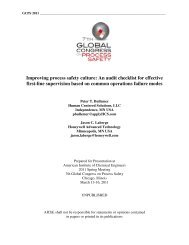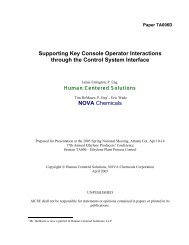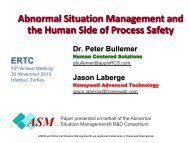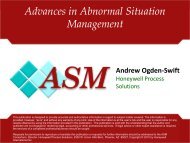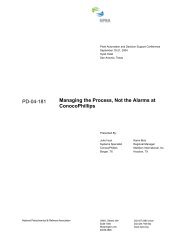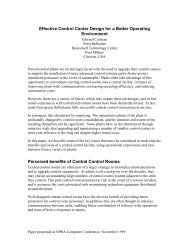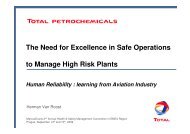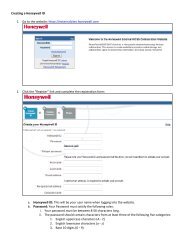Properly Handle Abnormal Situations - ASM Consortium
Properly Handle Abnormal Situations - ASM Consortium
Properly Handle Abnormal Situations - ASM Consortium
Create successful ePaper yourself
Turn your PDF publications into a flip-book with our unique Google optimized e-Paper software.
<strong>Properly</strong> <strong>Handle</strong> <strong>Abnormal</strong> <strong>Situations</strong>Providing effective operating procedures is crucial to successBy Peter T. Bullemer, Human Centered Solutions, LLCUse of procedures is an integral part of operating a large industrial process to achieve consistent,safe production. Industry regulations, e.g., OSHA 1910, require companies to provide writtenoperating procedures that contain clear instructions for safely executing activities for startup andshutdown as well as normal, temporary and emergency operations. This article discusses somekey challenges with procedural operations identified in an analysis of major industry incidentreports by the <strong>Abnormal</strong> Situation Management (<strong>ASM</strong>) <strong>Consortium</strong>, www.asmconsortium.org,and recommended practices to mitigate the associated risks.In the context of this article, the term "procedure" refers to a written document containing stepby-stepwork instructions to complete a single objective such as starting up a process unit. Thecommon business drivers for use of procedures are to avoid safety and environment incidents,establish efficient and effective operations, and supplement employee knowledge andexperience.The <strong>ASM</strong> <strong>Consortium</strong> defines an abnormal situation as an event disturbing a process thatrequires the operations team to intervene to supplement the control system. This definitionspecifically is used to distinguish among normal, abnormal and emergency situations from theperspective of console operations. The objective of abnormal situation management is to returnthe process to normal before safety systems are engaged.The consortium's focus on the use of procedures has been to examine whether enhancements tothe procedure management system might enable operators to more effectively prevent or respondto abnormal situations.PROCEDURE EXECUTION FAILURESTo better understand how to improve use of procedures, the <strong>ASM</strong> <strong>Consortium</strong> conducted a studyto investigate procedure execution failure modes associated with abnormal situations [1]. A teamexamined root causes of failures covered in a previous analysis of 32 process industry incidentreports. That earlier analysis [2] indicated that ineffective use of procedures significantlycontributed to major incidents and represented 8% of all root causes.The team assessed whether the procedural failure occurred prior to or during an abnormalsituation; those arising beforehand were deemed irrelevant to procedure execution during theabnormal situation. The analysis showed that 40 of the 70 identified procedure-related rootcauses, i.e., 57%, were linked to procedure execution failures in abnormal situations (Table 1).How these root causes manifest themselves provides better insight into how to makeimprovements in operations practices than the more generic root cause classifications [2].Examination of the 40 identified root causes showed the most common manifestation was
<strong>Properly</strong> <strong>Handle</strong> <strong>Abnormal</strong> <strong>Situations</strong>associated with lack of knowledge about appropriate responses to the occurrence of an abnormalsituation while executing a procedure (Table 2) — followed by the failure to detect the presenceof an abnormal equipment or process mode while executing a procedure, and the lack ofunderstanding the impact or effect of performing or not performing a procedural action. In total,these three accounted for 87.5% (35 out of 40) of the procedural execution failures underabnormal situations.Table 1: More than half of inadequate responses to abnormal situations stemmed from procedure execution failures.Root Cause AnalysisBased on this analysis, the study team identified the need for effective procedure content in thefollowing areas to improve operations' performance during abnormal situations:• Responding appropriately to the occurrence of an abnormal situation in the execution of theprocedure;• Detecting whether equipment or the process are in abnormal mode and whether there are anylatent abnormal conditions;• Spotting excursions from normal operating range and knowing the indications of theoccurrence of an abnormal situation; and• Understanding the correct impact or effect of a procedural action and the repercussions of notfollowing the procedural instruction.Table 2: Inappropriate action most often compromised procedure execution during abnormal situations.Published in ChemicalProcessing.COM, January 2013 Page 2
<strong>Properly</strong> <strong>Handle</strong> <strong>Abnormal</strong> <strong>Situations</strong>ADDRESSING THE CHALLENGESThe analysis of common root causes and root cause manifestations suggests a need forimprovements not only in the content of procedures but also in the procedure managementsystem itself. Based on this analysis and plant experiences, the <strong>ASM</strong> <strong>Consortium</strong> memberrepresentatives identified three challenges to reduce the risk of procedure execution failureduring abnormal situations:1. Organizational culture that fails to enforce an effective policy on use of procedures. This is asymptom of a failure to establish a policy that's compatible with the pragmatics of the operationswork environment. Even if a formal policy is in place, it typically just notes that employees areexpected to follow procedures at all times. Often the policy doesn't clearly state whether"following procedures" means personnel may recall the procedure from memory or must havethe written procedure in their hands during its execution.Most plants adopt a pragmatic practice of letting individual operators decide how they will use aprocedure document. Any given operator may be expected to know and follow dozens ofprocedures. The frequency, complexity and potential risks may differ quite significantly amongthese procedures. However, the typical policy doesn't distinguish between a simple, routineprocedure with low risk, such as swapping pumps, versus a complex, non-routine plant startupprocedure with high risk. Moreover, left to the discretion of the individual, whether a proceduredocument is used prior to or during execution can vary substantially.One of the <strong>ASM</strong> <strong>Consortium</strong>'s recommended effective practices is to establish a risk-basedmethodology to classify procedures in terms of usage. The methodology rates procedures basedon expected frequency of use, complexity and potential consequences if the procedure isn'tfollowed. Using the risk rating, procedures are classified into three categories:• Critical — typically low frequency, high complexity and serious consequences;• Reference — generally moderate frequency, complexity and consequences; and• Guidelines — usually high frequency, low complexity and minor consequences.Performance ProblemsFrom a usage perspective, the policy should state for each classification level whether theprocedure requires:• Reviewing prior to use;• Having the full document or a checklist on hand during execution;• Initialing each step following completion; and• Signing-off following completion of all steps or group of steps.Finally, the plant management team must monitor and reinforce compliance with the policy toensure operations team members adopt the new practice. Changing organizational culture isn'tsimple — it just won't happen automatically with the reclassification of procedures. However, amore pragmatic approach to the organization's expectations on the use of procedures will easethe task.2. Lack of effective methods for determining what abnormal situations procedures shouldPublished in ChemicalProcessing.COM, January 2013 Page 3
<strong>Properly</strong> <strong>Handle</strong> <strong>Abnormal</strong> <strong>Situations</strong>address. This inherently is about understanding the risks associated with failing to execute aprocedure as written and what situations might arise that might make executing the procedure nolonger appropriate. Consequently, addressing the challenge requires the use of a risk assessmentmethodology.The <strong>ASM</strong> <strong>Consortium</strong>'s recommended practices [3] use such methodologies to:• Establish risk-based criteria for procedural use classification (Guideline 1.5); and• Conduct a procedure-focused process hazard analysis (PHA) as part of critical review(Guideline 1.7).We've already discussed the role consequence plays in classifying procedures. Clearly, thisrequires some type of assessment of potential hazards associated with the failure to execute theprocedure. Sites that have done this assessment use their usual PHA or Hazard and Operability(HAZOP) methodology. The classification results can be used to identify the specific proceduresthat require a procedure-focused PHA to determine the content appropriate for execution duringabnormal situations, i.e., per the second guideline (Guideline 1.7).Evaluating the risk associated with the process and operator actions during procedures canidentify ways to manage and control hazards that might result from failures in execution. Inperforming this activity, the procedure developer must be knowledgeable about past PHAfindings and aware of specific engineering controls that improper execution of the proceduremight impact. Furthermore, because the original PHA findings might not have considered theprocedures in the analysis of risk, the procedure developer must pinpoint risk specificallyassociated with procedure execution failure.The strategy of using risk-based assessment methods for procedure development isn't a newconcept to the <strong>ASM</strong> <strong>Consortium</strong> members. However, using a risk-based methodologyspecifically to address the procedural execution failures associated with abnormal situations is anew emphasis evolving out of the recent incident analysis study.These best practice guidelines represent a starting point. However, a gap still seems to exist inaddressing the challenge associated with the procedure development strategy for determiningwhat abnormal situation or condition might arise that impacts continuation of the procedure.So, to get a more comprehensive grasp of sources of risk associated with execution failures underabnormal situation management, consider:• Failure to detect abnormal condition;• Failure to detect abnormal situation;• Lack of understanding of impact;• Lack of awareness of hazard; and• Inappropriate response to abnormal situation.Published in ChemicalProcessing.COM, January 2013 Page 4
<strong>Properly</strong> <strong>Handle</strong> <strong>Abnormal</strong> <strong>Situations</strong>In addition, to better consider the implications of an abnormal situation, when examiningpotential safeguards the reviewers should determine whether an action or actions would allowthe procedure to continue or whether it should be aborted.3. Insufficient metrics for understanding the causes of procedural failures. This implies aneed to enhance incident reporting to provide better information on the weaknesses of theprocedure management system. Any solution must address both metric definitions and metricreporting.Metric definitions should include both lagging and leading indicators. For instance, establish aset of lagging indicators that addresses failures in procedure scope, content or design that stymieprocedure execution in abnormal situations. Likewise, create a set of leading indicators thatidentify failures in management system elements.Leading indicator metrics should measure whether or not operations teams understand the plantpolicy on procedure use and whether personnel comply with the policy. These metrics can helpaddress the challenges associated with "Procedure Not Used."Incorporate the new lagging metrics into a common site reporting system that addresses allprocess safety incidents and promotes accurate and comprehensive reporting.Moreover, build the leading metrics into a common site reporting system that encouragesaccurate and periodic reporting — e.g., use the behavioral safety protocol for process safetymanagement interventions on procedures — not just behavioral safety (assessment, feedback andrecommendations for improving; and necessary number of observations per month). This mayrequire adapting the protocol to align with metric needs. Validate the effectiveness of the metricsin terms of reductions in the number of procedure-related incidents (per lagging indicators) aswell as procedural deviation observations.It's also crucial to establish an effective method for analyzing leading and lagging metrics overtime to determine systemic failures in procedure development practices.This suggested strategic approach to a more-comprehensive metrics-based solution forunderstanding the nature of procedure execution failures associated with abnormal situationsrequires effort to define procedure-related leading and lagging indicators and enhance thecommon site incident reporting system.ACHIEVE EFFECTIVE PROCEDURESIn general, the <strong>ASM</strong> <strong>Consortium</strong> analysis reinforces the value of establishing an effectiveprocedure management system for the development, deployment, and maintenance of procedurework instructions. The outlined approach to the analysis of incident reports can provide anyorganization with a good understanding of the specific ways to improve the proceduralmanagement system for better operations performance.Published in ChemicalProcessing.COM, January 2013 Page 5
<strong>Properly</strong> <strong>Handle</strong> <strong>Abnormal</strong> <strong>Situations</strong>PETER T. BULLEMER is senior partner at Human Centered Solutions, LLC, Independence,MN. E-mail him at pbullemer@applyhcs.com.LITERATURE CITED1. Bullemer, P.T., Kiff, L. and Tharanathan, A., "Common Procedural Execution Failure ModesDuring <strong>Abnormal</strong> <strong>Situations</strong>," J. of Loss Prevent. in Proc. Ind., pp. 814–818, 24 (6), 2011.2. Bullemer, P.T. and Laberge, J.C., "Common Operations Failure Modes in the ProcessIndustries," J. of Loss Prevent. in Proc. Ind., pp. 928–935, 23 (6), 2010.3. Bullemer, P. T., Hajdukiewicz, J. and Burns, C., "Effective Procedural Practices: <strong>ASM</strong><strong>Consortium</strong> Guidelines," <strong>Abnormal</strong> Situation Management <strong>Consortium</strong>, Minneapolis, MN, 2010.Published in ChemicalProcessing.COM, January 2013 Page 6



